The barnstormer that is the BMW S 1000 RR is all new for 2020. We got a few laps on the beast at Barber to see what it can do. Read all about it in our 2020 BMW S 1000 RR Review.
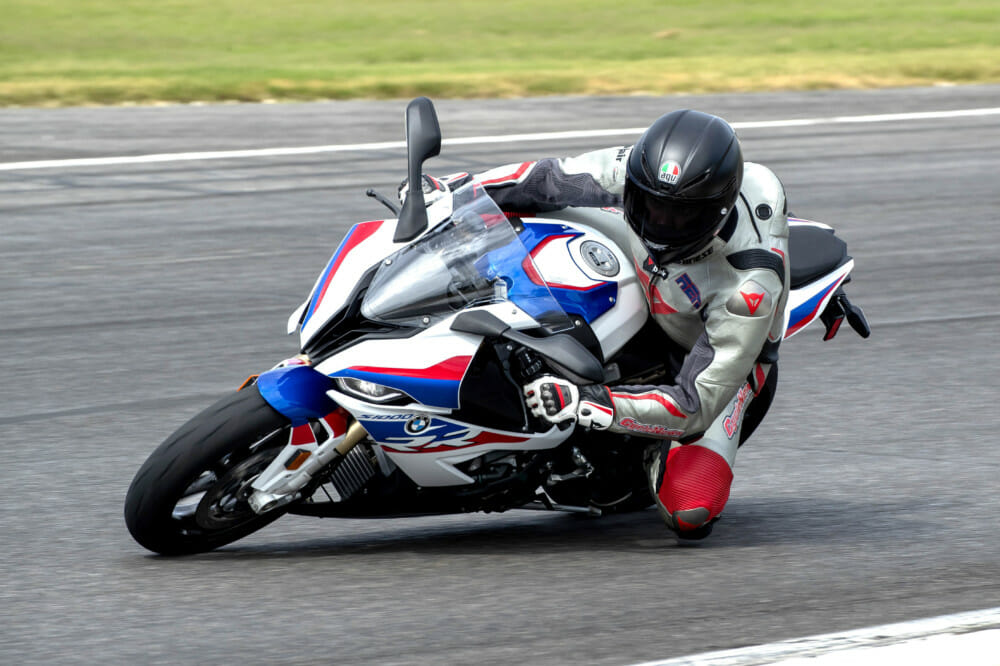
By any measure, the BMW S 1000 RR is a landmark motorcycle. Looking at the annals of modern sportbike history, the S 1000 RR of 2010 was the first true digital sportbike, utilizing not just variable riding modes (something we’d only seen a few years prior on the Suzuki GSX-R) but traction control and ABS—something we now take for granted.
Rudimentary as it may seem now, the original S 1000 RR was the lightning bolt that connected riders with the kind of tech we normally see in high-end sports cars, and pushed the motorcycle industry into a new way of thinking.
It’s hard to believe 10 years has now passed since that OG Beemer hit everyone like a sledgehammer. In that time, it’s seen two major updates, but that’s all they were—updates. For 2020, however, the S 1000 RR is ground-up new. Lighter, more powerful, and faster everywhere than the old machine, this is BMW putting its best foot forward with a machine that’s been four years in the making.
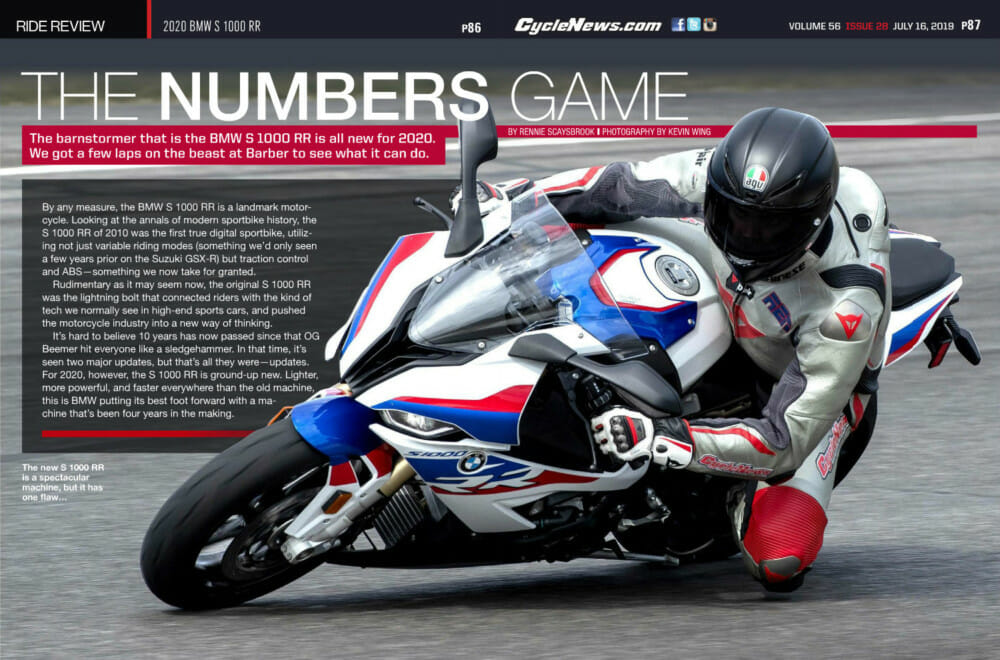
Click here to read this in the Cycle News Digital Edition Magazine.
In creating the 2020 BMW S 1000 RR, the men and women of Munich were tasked with one defining goal—to be one second faster around any track in the world that had seen an S 1000 RR in action before. That’s a lofty goal—especially as it’s incredibly difficult to define without the same test rider/weather/bike/tire set-up—but suffice to say the engineers went out of their way to make this thing as fast as humanly possible, while still playing within the rules of the class defining four-cylinder superbike regulation of 1000cc (no big-bore RSV4 1100/Panigale V4 S beater coming from BMW this time around).
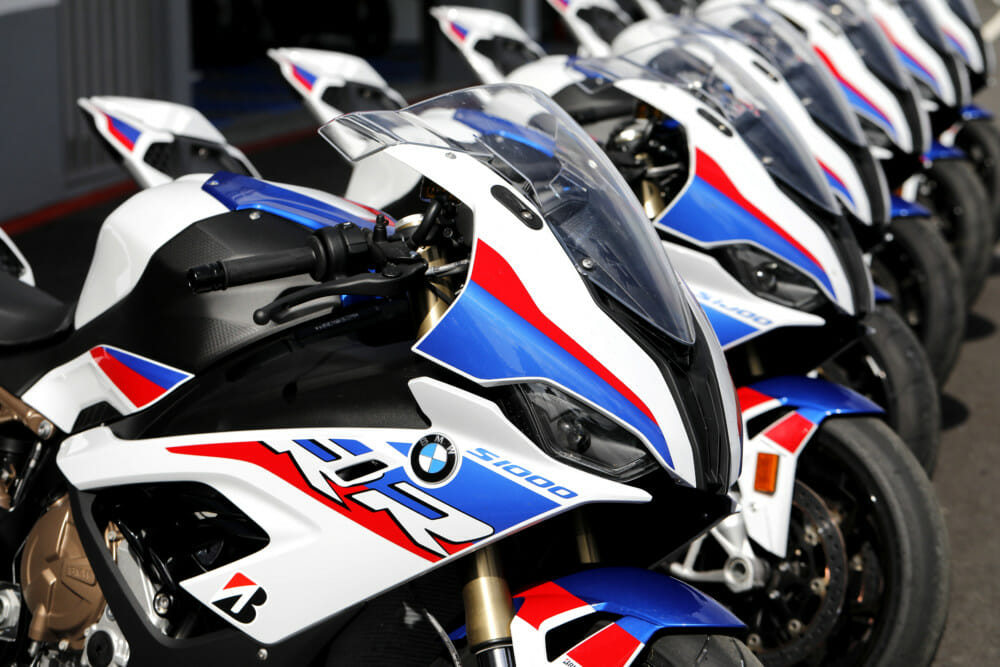
Everything (well almost everything) is new on the Beemer. Less than five percent of parts have been carried over from the 2018 model, and that’s lumped in with an all-new electronics system that’s about as adjustable as any motorcycle carrying a license plate that has gone before it. Welcome to the digital age 2.0.
Inside the short-stroke engine sits a claimed 207 hp at 13,500 rpm with torque claimed to be 83.3 lb-ft, and the motor now revs 400 rpm higher thanks to a 4mm shorter stroke, conrods that are 10 percent lighter and the addition of BMW’s ShiftCam technology that debuted on the 2019 R 1250 GS.
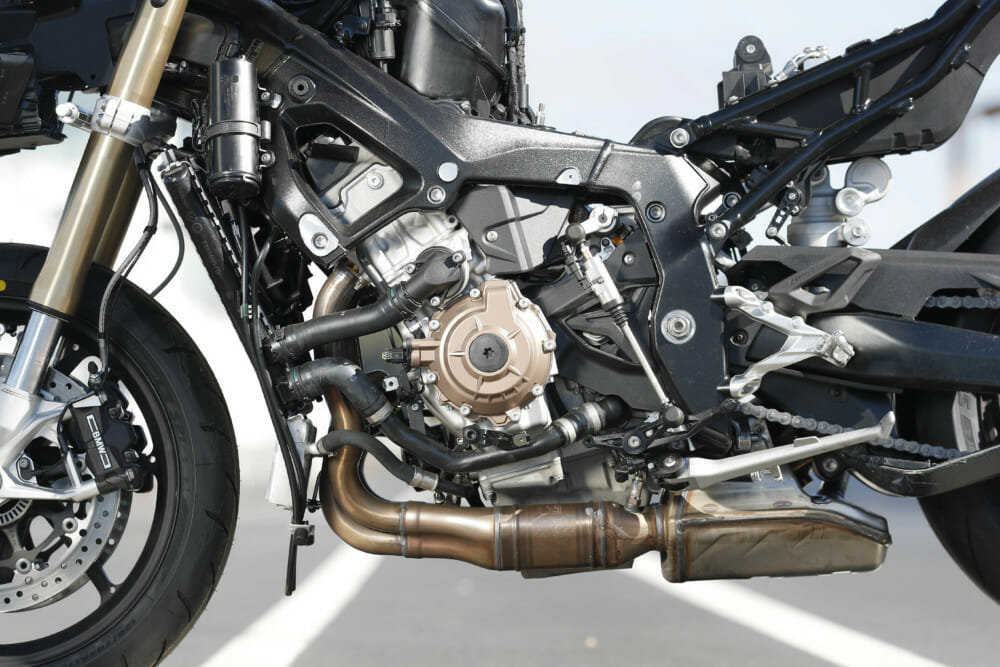
ShiftCam combines both variable valve timing and differential valve lift, all in the same package. The mechanism works with the new cam profiles and valve timing, and helps deliver a claimed 73 lb-ft from 5500 rpm all the way to the new 14,600 rpm limiter.
As before, the S 1000 RR gets an up and down quick shifter/autoblipper for the six-speed gearbox, enabling you to bang down the gears and have the revs matched perfectly by the ECU. On the chassis side, there’s a further 2lb weight saving, with the geometry much more nose-focused at 53.8/46.2 percent front to rear.
Weight is the enemy of acceleration and in total, the S 1000 RR has dropped a very handy (claimed) 24.3 pounds to measure 434.3 pounds with a full 4.4 gallon gas tank, ready to ride.
Should you wish to get the extensive nuts and bolts tech breakdown of the new S 1000 RR, please click this link and check out Alan Cathcart’s in depth report from the international press launch, held at a sodden Estoril in Portugal a few months ago. For this article, this will be a seat of the pants blast around the impossibly beautiful, almost country club-like surrounds of Barber Motorsports Park.
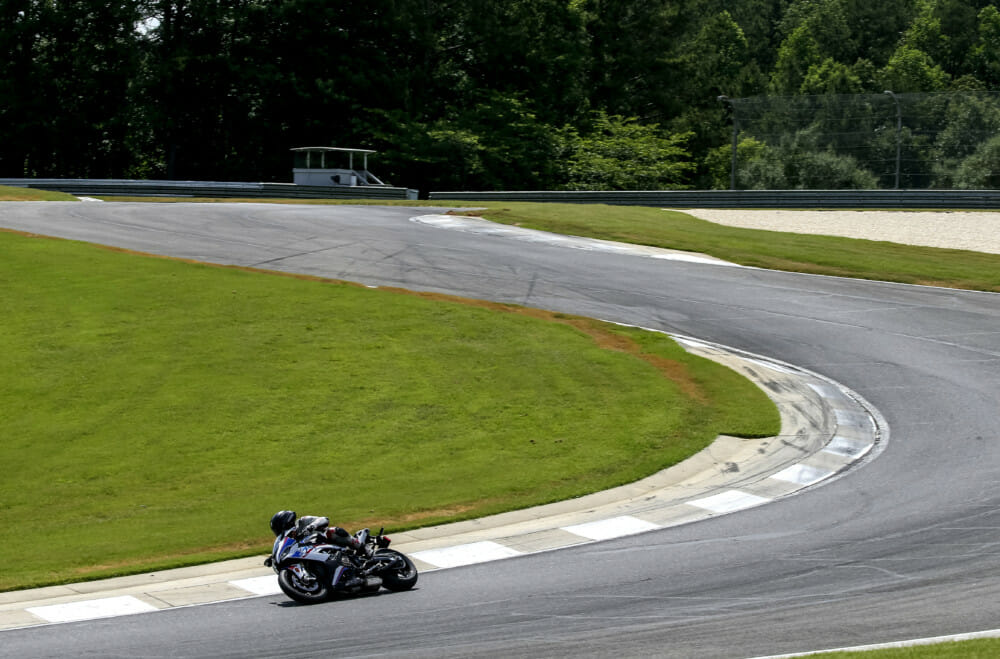
Spinning Laps on the 2020 BMW S 1000 RR
Any time you straddle a new bike, there’s one thing that stands out above all else—weight. Take the bike off the stand and your senses are immediately struck by how nimble the BMW feels just at standstill, as you rock the gas tank between your knees.
The bike I’m testing is BMW’s M-package, which gives the rider sensational carbon fiber wheels, lithium ion battery, a different seat and an adjustable swingarm pivot. BMW claims this thing weighs a stunning 427 pounds, and I have absolutely no reason to doubt that.

The second is the almost Tesla-like, 6.5-inch TFT dash that encompasses more electronics than any bike I’ve ever tested. To study and actually work the dash takes hours. Everything is adjustable—from the Dynamic Damping Control (DDC) suspension, to the rider modes, traction and ABS, it’s all accessed through the TFT display.
One thing BMW has pulled off is to make each electronic adjustment relatively simple. Considering the incredibly vast amount of information at your fingertips, ensuring each mode is easy to access is no mean feat. However, BMW has long been the leader in electronics in the superbike game so this is an area I shouldn’t be surprised in.
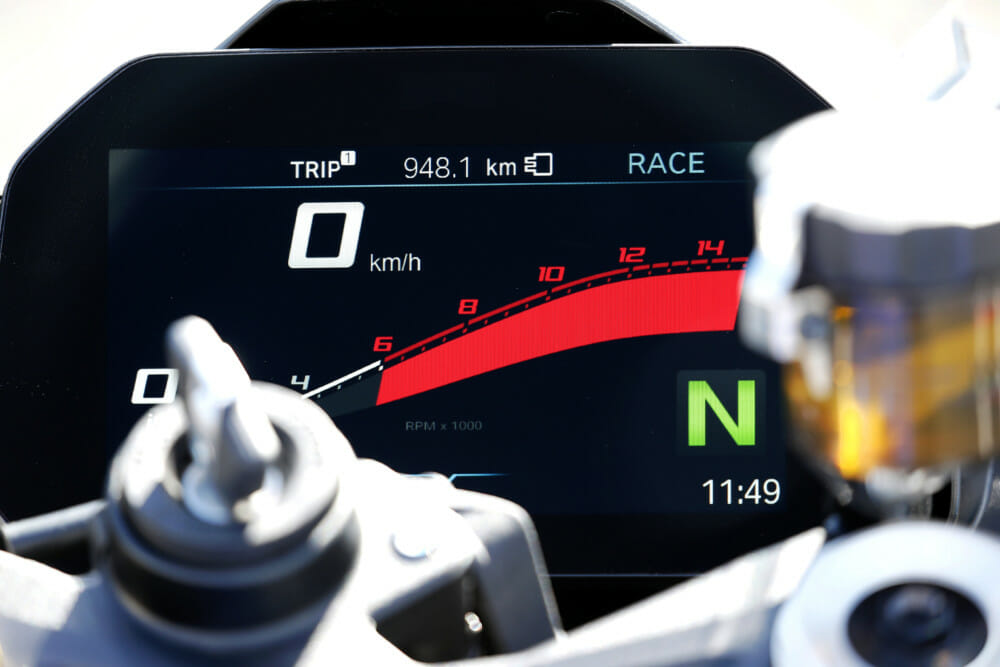
On that note of the DDC, this is a system that acts every 10 milliseconds—the fastest available yet to a production machine. The system is constantly monitoring and adjusting the suspension according to the given situation. There’s a distinctly digital feeling when riding the S 1000 RR from the front end, and it can take a bit of time to trust the system, especially if you’re used to riding on well set up, conventionally-adjusted suspension. The S 1000 RR is a case of learn first, trust second, and go for it thirdly.
Once you learn the language of the S 1000 RR’s suspension, the ride is superbly stable, yet fluid at the same time. High-speed stability is exceptional, especially when hitting the back straight left/right at Barber when the bike properly unloads itself down the hill, then loads right back up on the uphill right hander.
You don’t need to boss the new S 1000 RR from corner to corner like the old one, but you do need to let it know who is in charge. It’s a bike that needs to be ridden with purpose. BMW’s superbike is almost terrifyingly fast, and you need to be on your toes to ensure things don’t happen too quickly, especially on acceleration.
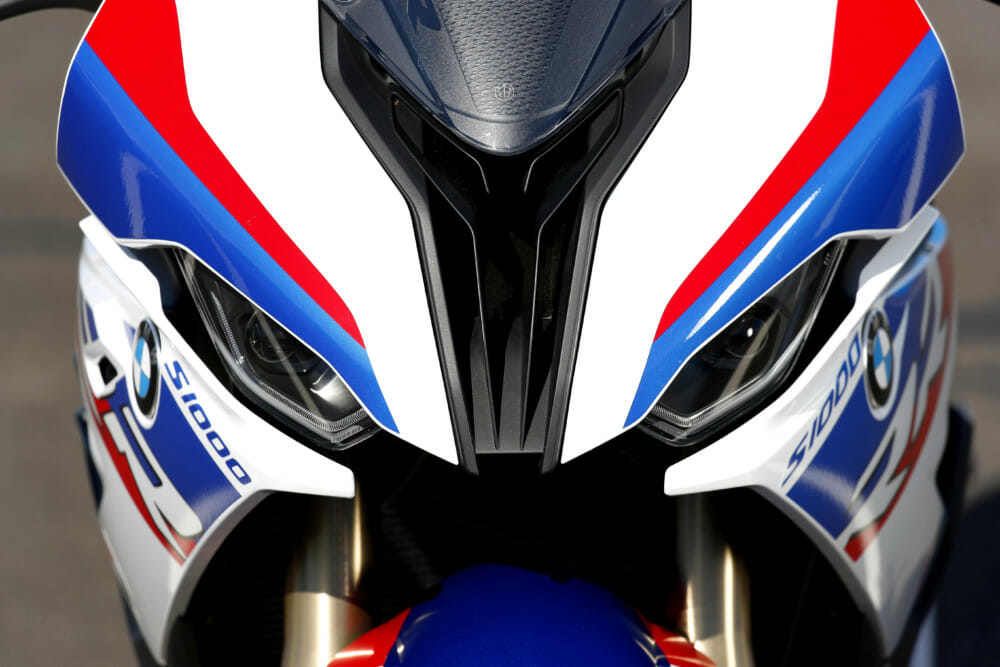
Herein lies the one major flaw with the 2020 BMW S 1000 RR. And the worst part is it is absolutely not BMW’s fault.
Under acceleration, especially from low speed and revs, the American spec S 1000 RR has a terrible flat spot that is cleared around the same rpm as when the ShiftCam kicks in, a little after 6000 rpm.
This comes from the EPA putting in severe restrictions on the noise levels that the Beemer can give off, and it flatly ruins what is otherwise a brilliantly smooth power delivery. I know this because I rode a European-spec S 1000 RR at Jerez a few months ago, and it was nothing short of superb, with strong driving power from as little as 3000 rpm, right through to redline.
This folly with the U.S.-spec S 1000 RR can likely be tuned out with an exhaust and an ECU upgrade, but it’s a real bummer for BMW, as it has done absolutely nothing wrong. They’ve built a brilliant bike, and the EPA has muzzled it.
Once you clear that flat spot, especially when you’re in the Race Pro ECU modes, the Beemer absolutely rips. It has top-end power like a titan, charging at the redline so fast you keep searching for gears—and that’s with standard road gearing. It’s an exceptional motor, matched to a beautifully mapped throttle and suspension that does everything for you on the fly.

Is the 2020 BMW S 1000 RR a Real World Winner?
The EPA issues aside, the S 1000 RR of 2020 is indeed a stellar motorcycle. The build quality on the M-Sport package is absolutely second to none, and takes much of the design lust you normally see on BMW’s topline four wheelers finally into the motorcycle realm.
I am personally a huge fan of the new aesthetic of lights that are no longer lopsided, as the overall look is now much more purposeful than before. And at $22,095 for the package we tested at Barber, you’re getting the very best BMW has to offer and carbon fiber wheels to boot, making this thing somewhat of a bargain.
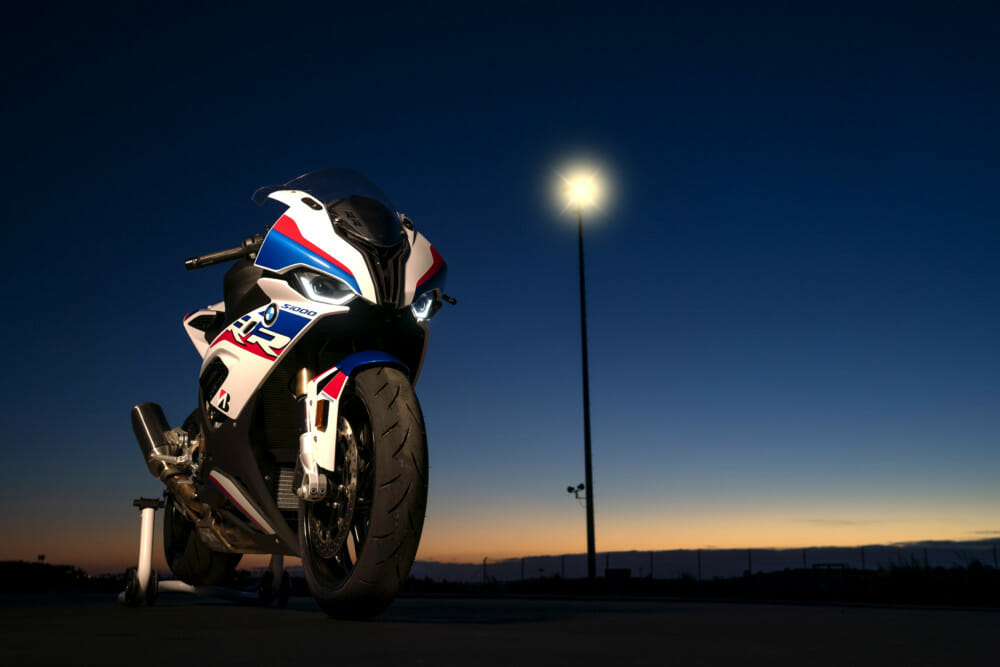
The next step will be for us to put the S 1000 RR on the street to see if the EPA problem is as big as it seems on the track. I think this won’t be the case, as the flat spot is only fully evident when searching for tenths of a second at the racetrack.
That’s why I can’t be mad at BMW for a problem that isn’t of their doing. It’s the world we now live in, I guess.
EPA aside, the engineers from Bavarian Motor Works have created a very worthy successor to the bike that started this electronics arm race in 2010. The 2020 BMW S 1000 RR is a best of a machine. CN
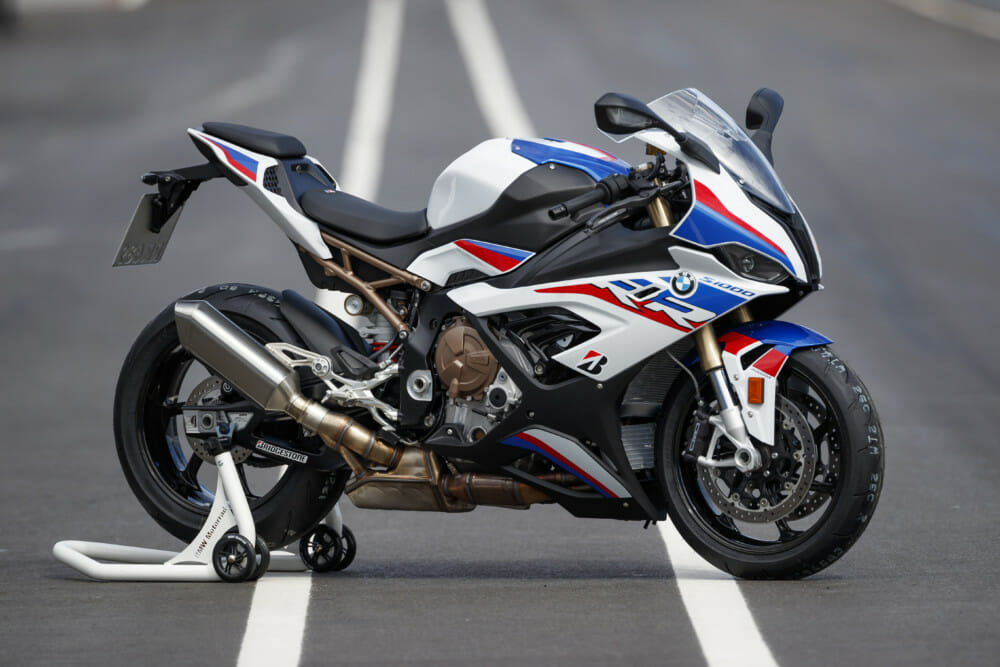
2020 BMW S 1000 RR Specifications
| MSRP | $16,995 standard / $22,095 M Package |
| ENGINE: | Water-cooled, 4-stroke, inline, 4-cylinder |
| VALVE DRIVE: | DOHC, 4-valves-per-cylinder, valve activation via individual rocker arms and variable intake camshaft control system BMW ShiftCam |
| DISPLACEMENT: | 999cc |
| BORE / STROKE: | 80mm / 49.7mm |
| OUTPUT: | 152kW/207hp @13,500 rpm |
| TORQUE: | 113Nm @ 10,500 rpm |
| THROTTLE VALVE DIAMETER: | 48mm |
| ENGINE CONTROL: | BMS-O |
| EMISSION CONTROL: | Closed-loop three-way catalytic converter |
| TRANSMISSION: | 6-speed, constant mesh |
| CLUTCH: | Self-reinforcing multi-plate anti-hopping wet clutch |
| REAR WHEEL DRIVE: | Chain |
| FRONT SUSPENSION: | USD telescopic fork, 45mm, fully adjustable, DDC option: damping electronically adjustable |
| REAR SUSPENSION: | Aluminum underslung double-sided swingarm w/ central spring strut, fully adjustable; DDC option: damping electronically adjustable |
| FRONT WHEEL TRAVEL: | 4.7 in. |
| REAR WHEEL TRAVEL: | 4.6 in. |
| FRONT BRAKE: | Twin 320mm disc, floating, radial 4-piston fixed calipers; BMW Motorrad ABS Pro |
| REAR BRAKE: | Single 220mm disc, 1-piston floating caliper; BMW Motorrad ABS Pro |
| TRACTION CONTROL: | BMW Motorrad DTC |
| WHEELS: | Die-cast aluminum wheels, carbon-fiber M Package option |
| FRONT WHEEL: | 3.50 x 17 in. |
| REAR WHEEL: | 6.00 x 17 in. |
| FRONT TIRE: | 120/70 ZR17 |
| REAR TIRE: | 190/55 ZR17 |
| WHEELBASE: | 56.7 in. |
| SEAT HEIGHT: | 32.4 in. |
| WEIGHT (wet, claimed): | 434.3 lbs. (standard) / 430.8 lbs. w/ Race Package option / 427.6 lbs. w/ M Package option |
| FUEL CAPACITY: | 4.4 gal. |
Click here to read this in the Cycle News Digital Edition Magazine.
Click here for more BMW motorcycle reviews and news.
Click here for the latest Cycle News Sportbike motorcycle reviews and news.
